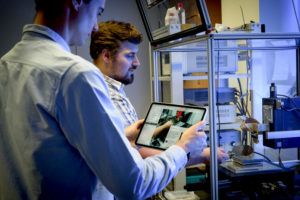Augmented Reality (AR) might render complicated paper-based work instructions for the maintenance or repair of complex machinery obsolete. At present, however, it takes an expert to create the complex AR applications. A novel software from Bochum enables people to make use of Augmented Reality without any prior knowledge. Dr. Mario Wolf and Jan Luca Siewert published a report on their work in Rubin, the science magazine at Ruhr-Universität Bochum (RUB). “Our aim is to make AR usable for everyone,” says Mario Wolf.

Goodbye paper: A software from Bochum enables people to create Augmented Reality manuals without any prior knowledge in that field. © Roberto Schirdewahn
With the Bochum-made software, users can create AR work instructions based on a modular system. First, they translate an existing manual step by step into a digital manual in a web application, while the software suggests various icons and text boxes as well as the option to upload photos and PDF files. Once the instructions are set up, the user takes a tablet to the respective unit for which the AR manual is being created. By tapping on the display, the user can match individual instructions with the real equipment and determine the position of warning signs, hints and icons.
Tablet navigates automatically
Throughout the entire process, the tablet navigates the space automatically. All the user has to do is define an origin at the beginning. To this end, he prints an image marker on a DIN-A4 sheet of paper and puts it up somewhere near the unit. The software automatically recognises that marker as starting point as soon as the camera points at it. Subsequently, the user can move freely across the room in order to set up his AR manual. Via motion sensors and point cloud capture installed in the tablet, the program knows its location in the room automatically – even if the image marker is no longer visible to the camera. Under real-world conditions, the software can position information with an accuracy of a few centimetres.
Usability study coming soon
Designed for Apple iPads, the program is currently in development and is used only at Ruhr-Universität Bochum; it is not yet available at an App Store. Various RUB engineering departments are using it to generate manuals for complex research equipment. But the industry has already shown interest in the product. In autumn 2019, a usability study with students of mechanical engineering as well as from other faculties is going to commence; based on the results, Mario Wolf and Jan Luca Siewert will continue optimising the application.
Source: Ruhr-Universität Bochum